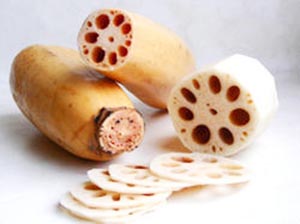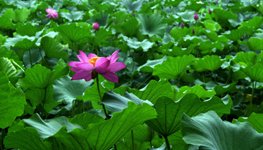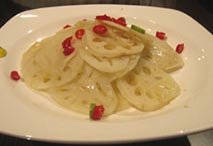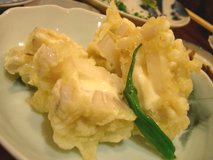Lotus root Nutrition facts
Crunchy, delicate flavored, lotus root is an edible rhizome (root) of the lotus plant. Almost all the parts of the plant: root, young flower stalks, and seeds are being employed in the cuisine.
Lotus is a herbaceous perennial aquatic plant belonging to Nelumbonaceae family. Scientific name: Nelumbo nucifera. The rhizome is popular as ren kon (れんこん) in Japan and ǒu (藕) in the mainland China. For centuries, the lotus plant and its parts held high esteem in the far East societies, especially in the Chinese and Japanese cultures.
 |
| Peeled cut section of lotus rhizome (Nelumbo nucifera). |
Lotus roots grew as annual root-vegetable crops in the customized ponds in swampy, underwater environments. It is a modified tuber that stores energy in the form of starch. A completely grown lotus root appears like a sausage link into three to five intersecting nodes, measuring about 2-4 feet in length.
Farmers normally prefer direct implantation of sections of rhizomes with meristems (growing points) over sowing seeds since it takes overall fewer days for the production of the entire crop.
In about 5-6 months after setting, lotus rhizomes are ready for harvesting. Farmers normally recognize this by the appearance of large floating leaves on the surface of the water that coincide with the readiness of rhizome formation for harvesting.
Each rhizome segment features a smooth, gray-white tube measuring about 10-20 cm in length, and 3-7 cm in diameter. Internally, the root has white, crunchy flesh with a mildly sweet, water-chestnut-like flavor. On cross-section, the lotus root reveals a visually appealing display of symmetrically arranged air canals (holes) traversing all along its length.
The lotus fruit (fruit-head) is an enlarged receptacle, akin to a sunflower-head, wherein numerous edible seeds are embedded in it.
Health benefits of Lotus root
Lotus root is one of the moderate-calorie root-vegetable. 100g root-stem provides about 74 calories. Nevertheless, it is composed of many health-benefiting phytonutrients, minerals, and vitamins.
Lotus rhizome is an excellent source of dietary fiber; 100 g flesh provides 4.9 g or 13% of the daily requirement of fiber. Dietary fiber, together with slow-digesting complex carbohydrates, helps reduce blood cholesterol, sugar, obesity, and constipation conditions.
Fresh lotus root is an excellent source of vitamin-C. 100 g root provides 44 mg or 73% of daily recommended values. Vitamin C is a powerful water-soluble antioxidant that is essential for collagen synthesis inside the human body.
Collagen is the main structural protein inside the body that maintains the integrity of blood vessels, skin, organs, and bones. Regular consumption of foods rich in vitamin C helps the body protect from scurvy, develop resistance against viral infections, boost immunity, and wound healing, and scavenge cancer-causing harmful free radicals from the body.
Further, the root contains moderate levels of some of the valuable B-complex group of vitamins such as pyridoxine (vitamin B-6), folates, niacin, riboflavin, pantothenic acid, and thiamin. Pyridoxine (vitamin B-6) works as a coenzyme in the neurochemical synthesis inside the human brain which influences mood and thought. Adequate pyridoxine levels help control nervous irritability, headache, and tension. It also cuts heart attack risk by decreasing harmful homocysteine toxin levels in the blood.
In addition, the root provides healthy amounts of some essential minerals like copper, iron, zinc, magnesium, and manganese. Copper is a cofactor for many vital enzymes, including cytochrome c-oxidase and superoxide dismutase (other minerals function as cofactors for this enzyme are manganese and zinc). Along with iron, it is also required for the production of red blood cells.
The Crunchy, neutral yet delicate flavor of root lotus is because of its optimum electrolyte balance at an agreeable ratio of sodium to potassium at a ratio of 1:4. While sodium gives a sweet taste to the root, potassium counters the adverse effects of sodium by regulating heart rate, and blood pressure.
| Principle | Nutrient Value | Percent of RDA |
|---|---|---|
| Energy | 74 Kcal | 3.7% |
| Carbohydrates | 17.23 g | 13% |
| Protein | 2.60 g | 5% |
| Total Fat | 0.10 g | 0.5% |
| Cholesterol | 0 mg | 0% |
| Dietary Fiber | 4.9 g | 13% |
| Vitamins | ||
| Folates | 13 µg | 3% |
| Niacin | 0.400 mg | 2.5% |
| Pantothenic acid | 0.377 mg | 7.5% |
| Pyridoxine | 0.258 mg | 20% |
| Riboflavin | 0.220 mg | 17% |
| Thiamin | 0.160 mg | 13% |
| Vitamin A | 0 IU | 0% |
| Vitamin C | 44 mg | 73% |
| Electrolytes | ||
| Sodium | 40 mg | 3% |
| Potassium | 556 mg | 12% |
| Minerals | ||
| Calcium | 45 mg | 4.5% |
| Copper | 0.257 mg | 29% |
| Iron | 1.16 mg | 14% |
| Magnesium | 23 mg | 6% |
| Manganese | 0.261 mg | 1% |
| Selenium | 0.7 µg | 1% |
| Zinc | 0.39 mg | 3.5% |
| Phyto-nutrients | ||
| Carotene-ß | 0 µg | -- |
| Carotene-α | 0 µg | -- |
| Cryptoxanthin-ß | 0 µg | -- |
| Lutein-zeaxanthin | 0 µg | -- |
Selection and storage

|
| Lotus field in China. Photo courtesy: Nicolas Elvemo |
Lotus root (renkon-(藕)) harvest begins in August and lasts until fall. Traditionally, farmers sink their legs in knee-deep ponds and try to feel for the rhizome guiding their toes, which are then dug out by hand. The Southeastern region of China and Lake Kasumigaura in Ibaraki Prefecture in Japan are known for renkon-(藕) production.
From a distance, lotus rhizomes appear as big-sized bananas arranged in sausage patterns. While buying, look for fresh, firm roots with smooth, unblemished skin. Fresh roots are readily available year-round in the main cities in the USA. One can also buy sliced, canned, and freeze-dried roots in supermarkets or Japanese and other Asian stores.
Once at home, place the roots in a cool, dark place away from humidity for 3-4 days. Uncut rhizomes can stay fresh for up to 2 weeks inside the refrigerator.
Preparation and serving methods
Lotus root, known as renkon in Japan and Lián ou in Chinese, hold a special place in their cultures. The rhizome as well as lotus seeds; raw or cooked, are widely used in a variety of Eastern recipes in the Far East, Southeast Asia, and Pacific regions.
To prepare, break the root at nodal intersections into individual parts. Wash it thoroughly in cold running water before use. Trim the ends. Peel its rough outer tough skin using a paring knife to expose ice-white, daikon (radish) )-like flesh underneath. It can be cut into cubes, or julienned in ways desired as in other vegetables. Rinse the slices immediately in the vinegar or acidulated (lemon) water to prevent discoloration.
Here are some serving tips:
 |
| Lotus root salad with chili peppers. Photo courtesy: VirtualErn |

|
| Tempura style lotus root with camembert cheese. Photo courtesy: jetalone |
Young, clean, and tender rhizomes can be added raw to salads. However, mature rhizome tastes bitter and can be eaten only after cooked.
In Japan, renkon (れんこん) is one of the root vegetables used in tempura and kinpira style cooking. Sautée slices in soy sauce, mirin (rice wine), and chili peppers. Lotus root chips are popular snacks in Japan.
The root, popularly known as kamal ki kakari or bhe in India and Bangladesh, features in a variety of curry, stews, and stir-fries.
Chinese use the root in soups, stuffing, stir-fries, etc., especially in Cantonese-style cooking.
In China, lotus seeds are enjoyed as snacks, in soups, in cakes, and in condiments.
Safety profile
Lotus root may harbor parasites like Fasciolopsis buski, a trematode that commonly infests in aquatic plants like lotus, water caltrop (Trapa natans), Chinese water chestnut (Eleocharis dulcis), etc.
The symptoms of infestation may include stomach pain, vomiting, diarrhea, fever, and intestinal obstruction. Thorough washing and cooking under steam can destroy its larvae. (Medical disclaimer).
≻≻-Read Lotus seeds nutrition facts and Health benefits.
≻≻-Back to Vegetables from Lotus root. Visit here for an impressive list of vegetables with complete illustrations of their nutrition facts and health benefits.
≻≻-Back to Home page.
Further reading:
Stanford Medicine cancer center information page-Nutrition to reduce cancer risk .